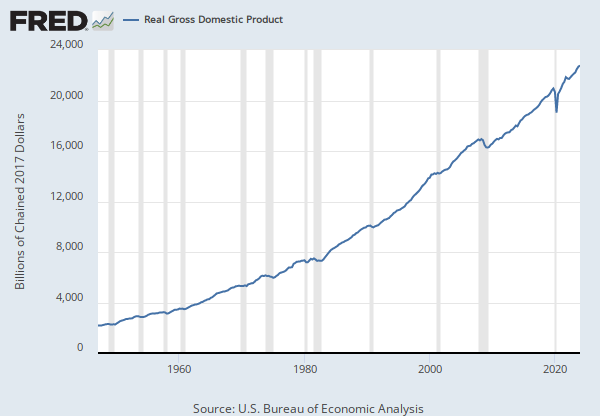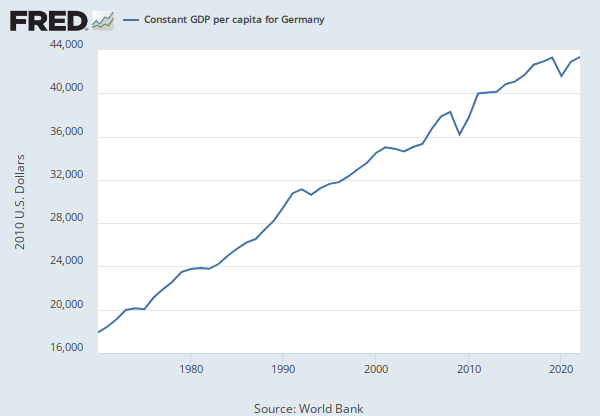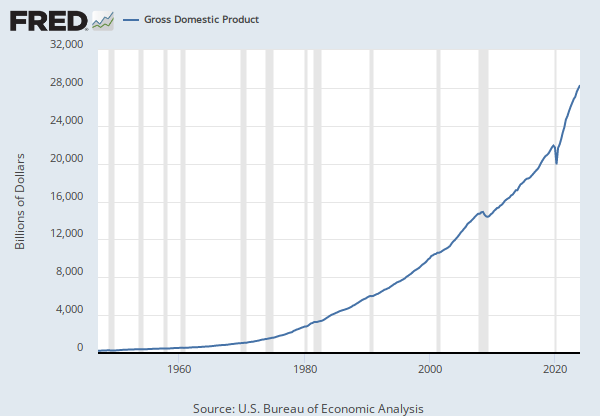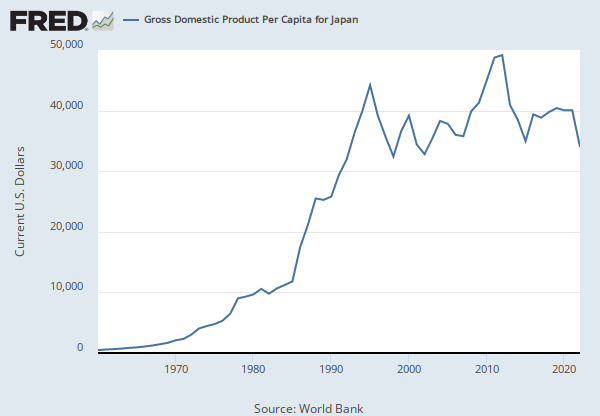FRED Graph
Data in this graph are copyrighted. Please review the copyright information in the series notes before sharing.
Notes
Source: World Bank
Release: World Development Indicators
Units: 2010 U.S. Dollars, Not Seasonally Adjusted
Frequency: Annual
Notes:
GDP per capita is gross domestic product divided by midyear population. GDP is the sum of gross value added by all resident producers in the economy plus any product taxes and minus any subsidies not included in the value of the products. It is calculated without making deductions for depreciation of fabricated assets or for depletion and degradation of natural resources.
World Bank national accounts data, and OECD National Accounts data files.
Suggested Citation:
World Bank, Constant GDP per capita for Japan [NYGDPPCAPKDJPN], retrieved from FRED, Federal Reserve Bank of St. Louis; https://fred.stlouisfed.org/series/NYGDPPCAPKDJPN, April 3, 2025.
Source: U.S. Bureau of Economic Analysis
Release: Gross Domestic Product
Units: Chained 2017 Dollars, Seasonally Adjusted Annual Rate
Frequency: Quarterly
Notes:
BEA Account Code: A939RX
For more information about this series, please visit the Bureau of Economic Analysis.
Suggested Citation:
U.S. Bureau of Economic Analysis, Real gross domestic product per capita [A939RX0Q048SBEA], retrieved from FRED, Federal Reserve Bank of St. Louis; https://fred.stlouisfed.org/series/A939RX0Q048SBEA, April 3, 2025.
Source: World Bank
Release: World Development Indicators
Units: Percent of Working-Age Population, Not Seasonally Adjusted
Frequency: Annual
Notes:
Age dependency ratio, old, is the ratio of older dependents (people older than 64) to the working-age population (those ages 15-64). Data are shown as the proportion of dependents per 100 working-age population.
Source Indicator: SP.POP.DPND.OL
Suggested Citation:
World Bank, Age Dependency Ratio: Older Dependents to Working-Age Population for Japan [SPPOPDPNDOLJPN], retrieved from FRED, Federal Reserve Bank of St. Louis; https://fred.stlouisfed.org/series/SPPOPDPNDOLJPN, April 3, 2025.
Source: World Bank
Release: World Development Indicators
Units: Percent of Working-Age Population, Not Seasonally Adjusted
Frequency: Annual
Notes:
Age dependency ratio, old, is the ratio of older dependents (people older than 64) to the working-age population (those ages 15-64). Data are shown as the proportion of dependents per 100 working-age population.
Source Indicator: SP.POP.DPND.OL
Suggested Citation:
World Bank, Age Dependency Ratio: Older Dependents to Working-Age Population for the United States [SPPOPDPNDOLUSA], retrieved from FRED, Federal Reserve Bank of St. Louis; https://fred.stlouisfed.org/series/SPPOPDPNDOLUSA, April 3, 2025.
Release Tables
Related Data and Content
Data Suggestions Based On Your Search
Content Suggestions
Related Categories
Releases
Tags
Permalink/Embed
modal open, choose link customization options
Select automatic updates to the data or a static time frame. All data are subject to revision.








































